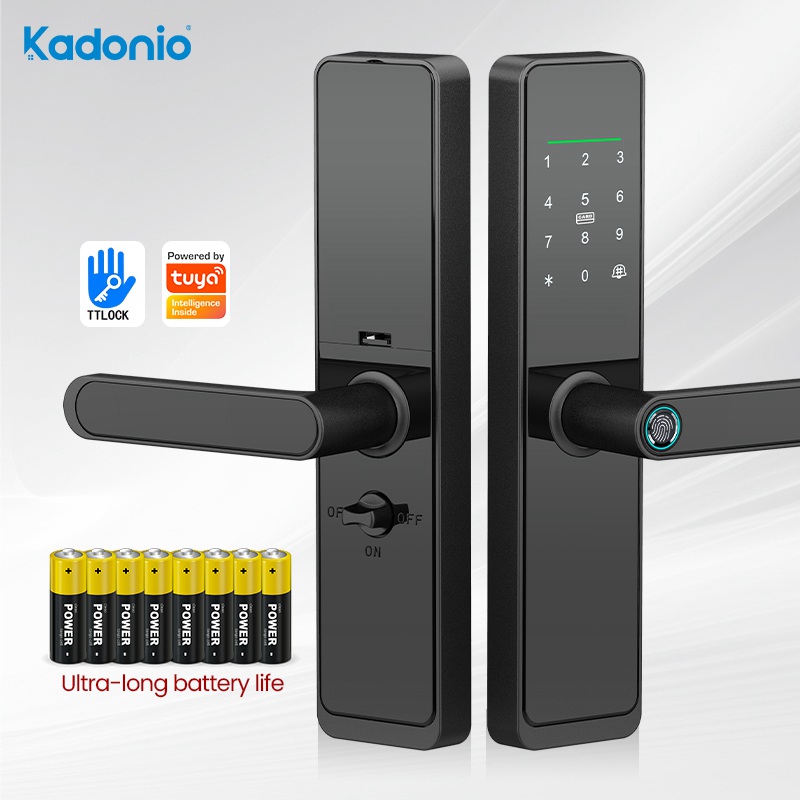- What is a Smart Door Lock?
A smart door lock is an advanced locking system built on the foundation of traditional mechanical locks. It combines security, convenience, and innovation, using technologies like password recognition, fingerprint identification, facial recognition, IC cards, and Bluetooth modules. These locks also support Internet of Things (IoT) functions, connecting to local and wide area networks. Smart door locks are widely used in banks and government agencies for enhanced security and in hotels, school dormitories, residential communities, villas, and guesthouses for convenient management.
- What Are the Current Unlocking Methods for Smart Locks?
Smart locks available on the market today offer several unlocking methods:
- Biometric Identification: Fingerprint, facial recognition, finger vein, palm vein, and iris scanning.
- Bluetooth: Unlocking via mobile phone Bluetooth or Bluetooth buttons.
- Traditional Method: Backup mechanical key.
- Other Methods: Password, NFC card, WeChat, remote, and temporary password unlocking.
- Should the Upper and Lower Bolts Be Left When Installing a Smart Door Lock?
It is recommended to remove the upper and lower bolts. While these bolts enhance the physical security of the door by reinforcing the connection with the door frame, they do not provide additional technical security. They can increase the complexity of the lock, leading to higher failure rates and maintenance costs. Additionally, the increased load on the lock body due to additional components can weaken its durability over time.
- Why Do Smart Locks Still Have Backup Keyholes?
Smart locks typically incorporate three emergency unlocking methods: mechanical key, dual-circuit drive, and password dial. Most smart locks use a concealed mechanical keyhole as a backup for emergency situations like power failure or fire damage. The mechanical keyhole, though rarely used, ensures that the lock can be opened when other electronic methods fail.
- What Are Optical and Semiconductor Fingerprint Recognition?
- Optical Fingerprint Recognition: This technology involves placing the finger on an optical lens. An internal light source illuminates the finger, and a prism projects the fingerprint image onto a charge-coupled device (CCD). This process creates a digital, multi-gray fingerprint image that can be processed by fingerprint algorithms.
- Advantages: Widely used, adapts to temperature variations, relatively low cost.
- Disadvantages: Larger size, reduced recognition accuracy for very dry or oily fingers.
- Semiconductor Fingerprint Recognition: This method can be capacitive or inductive. It involves a semiconductor device array that forms a capacitive or inductive surface when a finger touches it. The uneven surface of the finger creates varying capacitance or inductance values, which are collected and processed to form the fingerprint image.
- Advantages: Closer to live recognition, highly sensitive and accurate, low power consumption, compact size.
- Disadvantages: Higher cost, more delicate maintenance.
- What Is Finger Vein Recognition?
Finger vein recognition identifies individuals based on the vein patterns inside their fingers. Using near-infrared light and a CCD camera, it captures and stores the digital image of the finger veins. This method is particularly suitable for home security due to its compact size and fast recognition speed.
- What Are Mechanical and Electronic Lock Bodies?
Smart locks can have either mechanical or electronic lock bodies.
- Mechanical Lock Body: This is a purely mechanical structure without any electronic components, similar to traditional locks, often featuring a through-hole design for easy installation.
- Mechanical-Electronic Integrated Lock Body: This combines mechanical and electronic elements, usually identified by a tail (data cable) that connects to the interior panel. The smart system controls the lock mechanism, allowing or preventing the connection with the square shaft, thus enabling or disabling door opening based on proper authorization.
- What Are the Communication Methods for Smart Door Locks?
Common communication protocols for smart locks include WiFi, Bluetooth, ZigBee, and Z-Wave.
- WiFi: High power consumption, suitable for large data transmission.
- Bluetooth: Low power consumption.
- ZigBee: Complex technology, high development cost.
- Z-Wave: Led by Zensys, not as strong as the ZigBee alliance.
- NB-IoT: Emerging technology offering longer standby times, no need for a gateway, better network stability, and a more secure environment.
Each wireless protocol has its advantages and disadvantages, with interoperability, security, and product availability being crucial selection factors.
- How to Know if Your Door Can Install a Smart Lock?
Smart locks are designed to fit most standard lock specifications, so in most cases, they can be installed without needing to replace the door. If your door has a rare or foreign lock type, modifications can be made to accommodate the smart lock. Smart locks can be installed on wooden, iron, copper, composite, and security doors, as well as office glass doors.
- What Is the Best Way to Maintain a Smart Door Lock?
Proper maintenance is crucial for the longevity and functionality of smart locks. Key points include:
- Avoid unauthorized disassembly.
- Do not slam the door.
- Use a dry, soft cloth to clean the sensor window to prevent scratches.
- Keep the lock away from water and corrosive substances.
- Avoid hanging heavy objects on the door handle.
- Do not apply lubricant randomly to the keyhole to prevent dust accumulation.
- Regularly check the lock and replace the battery in a timely manner.
Post time: Jul-19-2024





